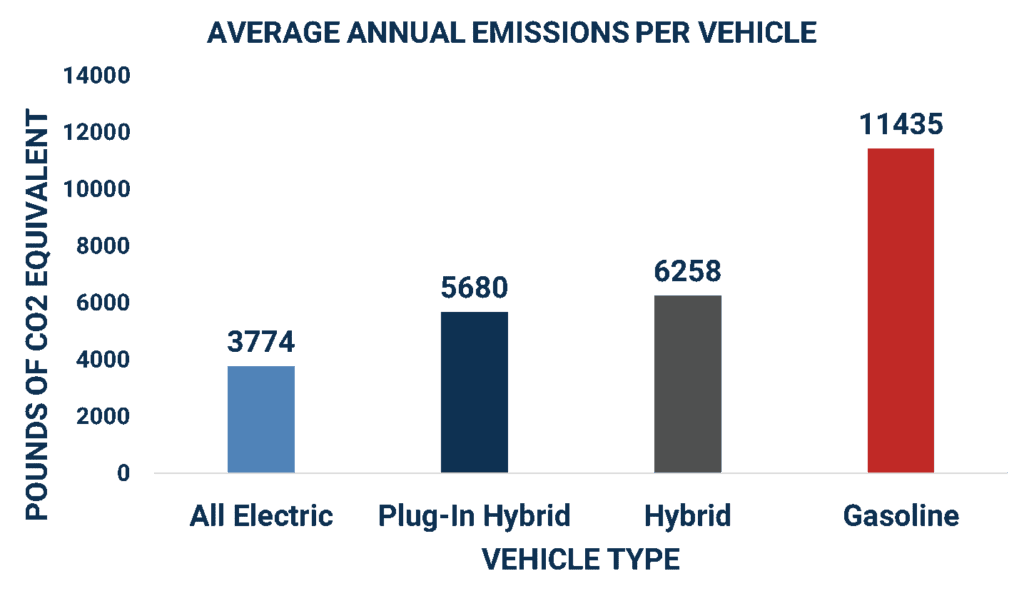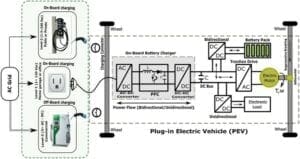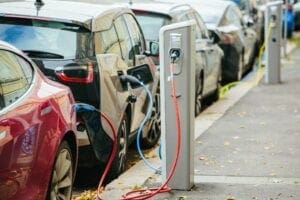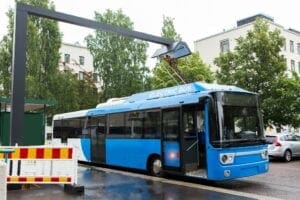What are Electric Vehicles?
Simply put, electric vehicles (EVs) are vehicles that run on electricity rather than on fossil fuels like oil and gas. Electric vehicles come in all shapes and sizes ranging from electric cars, busses, and trucks to electric bicycles, forklifts, and scooters. For EVs like electric cars, they typically cost less to power than gasoline powered vehicles.
Electric vehicles can be classified as EV, HEV, or PHEV. EVs are all electric, HEVs and PHEVs are hybrid-electric and plug-in hybrid electric, respectively, meaning they can run on both electricity and have an internal combustion engine. According to this article, EV’s need less maintenance than HEVs or PHEVs since there are fewer fluids, less brake wear, and fewer moving parts than found in a typical combustion engine. EVs, HEVs, and PHEVs also have far fewer carbon emissions than typical combustion engine, and if EVs run entirely on electricity, then their carbon emission can be zero.
 Graph Information via https://afdc.energy.gov/vehicles/electric_emissions.html
Graph Information via https://afdc.energy.gov/vehicles/electric_emissions.html
How do Electric Vehicles Work?
All EV’s have high-voltage voltage systems and large battery packs and that help them operate. The high voltage systems can range from 100V to 600V and the battery packs are highly advanced and need to be protected from a number of elements like collision and short circuit.
Since electric vehicles run on electricity, they need to be charged before they can be used. Different EV applications require different chargers and power supplies depending on their environment and unique requirements. Some electric vehicles, like cars, also feature regenerative braking, which will generate, rather than lose, energy during braking. Below is one example of what the internal makeup of an EV car could look like, including a battery pack, DC/DC converters, and bi-directional DC/DC converters.
 Photo Via researchgate.net
Photo Via researchgate.net
EVs will need to be charged at different voltages and lengths of time depending on their application and size. Different power levels will offer more or less charge time depending on the vehicle being charged and the length of time they are being charged for.
Electric Vehicle Charging
Electric Car Charging
The chargers for electric cars typically come in three tiers: 120V, 240V and DC Fast Charging. 120V chargers use AC power, have a 3-prong outlet, and can be plugged into an outlet in your home. The chargers usually are provided from the manufacturer of the car and are a typical method of charging an electric car in the home. Unfortunately, these chargers are not very powerful and can usually supply 2-5 miles of driving power per hour of charging.
The next level of electric car chargers after 120V is 240V chargers. This is another level of charging that is usually found in the home or possibly in workplace parking lots. These chargers use AC power, but they require a more complicated set up and wiring than the 120V charger. These chargers can usually supply 10-20 miles of driving power per one hour of charging.

The final level of electric car chargers is DC Fast Charging. These are the most powerful chargers available for electric car charging and use DC power derived from AC high power lines. This means that they are typically found in the public rather than the home. These chargers can provide up to 180 miles of driving power per hour of charging.
Electric Bus & Electric Truck Charging
Due to their large size, electric busses and trucks need 50kW – 200kW or even higher to get charged up. There is also no option to charge in a home setting, so bus charge stations usually need to be installed at bus depots. This means that these stations need to be able to handle large load requirements ranging from 2MW to 5MW according to this article. As technology advances, charge times for large vehicles like busses and trucks are getting faster and faster in order to get them back on the road as soon as possible. Some systems can charge up a bus for a 30 mile run in as little as 10 minutes, as described in this article.

Scooters & Bike Charging
Scooters and bikes need a much lower power level and are less complicated set up to charge than cars or busses are. Scooters typically have a simple 24V-36V wall mount battery charger that connects directly to the scooter. Larger scooters and bikes will need a higher voltage charger. They can take anywhere from 2-12 hours to fully charge depending on the model and charger. Electric scooters and bikes are convenient because they can easily be charged in the home and there are certain models that can hold charge for a very long time.
How are power supplies used in electric vehicles?
Power supplies are an essential part of any EV application. They can be found in the charging station, as the battery chargers, and in the electric vehicle themselves. Due to the environment that these supplies will be used in and the applications they are used for, they typically need to be isolated, have low noise, wide temperature ranges, and high efficiency. EV power supplies may also require protection from outdoor elements so they may have to have conformal coating, hermetic sealing and thermal protection. PFC may also be required for EV power supplies to meet regulations and UL approval is also important for safety. For more information, see our line of EV power supplies on our website. Wall Industries is always interested in designing for specific requirements in a custom or modified standard design.
Sources:
https://www.epa.gov/greenvehicles/plug-electric-vehicle-charging
https://www.greencarreports.com/news/1098401_electric-car-charging-the-basics-you-need-to-know
https://afdc.energy.gov/vehicles/electric_maintenance.html
